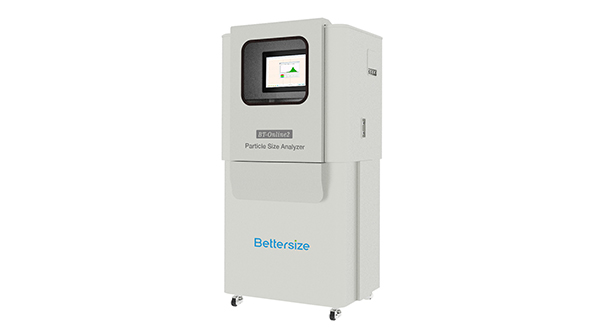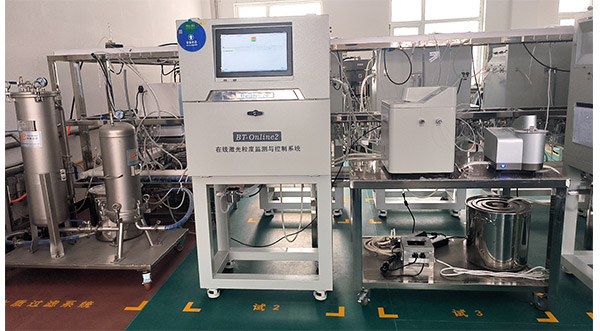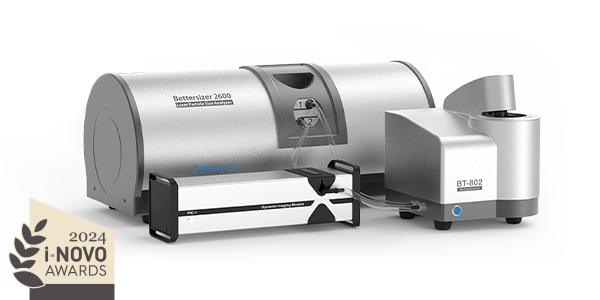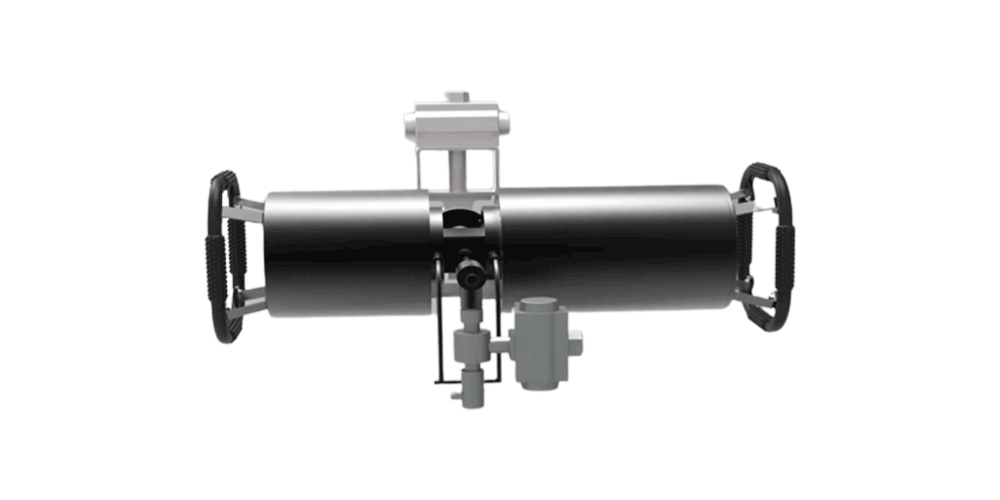BT-Online2
Das BT-Online2 verwendet das patentierte optische Fourier- und Inverse-Fourier-System und liefert zuverlässige Messergebnisse mit der gleichen Genauigkeit wie ein Laborgerät. Im optischen Aufbau sind insgesamt 92 Detektoren präzise angeordnet, die für eine genaue Partikelgrößenanalyse im Bereich von 0,02 bis 2000μm unter Verwendung der Nassmethode verantwortlich sind. Mit einem externen Verdünnungssystem kann das BT-Online2 Proben mit hohem Feststoffgehalt verarbeiten, was seine Anwendungsbereiche erheblich erweitert. An das BT-Online2 können bis zu 4 Prozesslinien angeschlossen werden, was Ihre Investition spart, Ihre Raumeffizienz verbessert und die Datenverwaltung vereinfacht.
Funktionen und Vorteile
- ● Patentierter optischer Aufbau fördert die Messgenauigkeit
- ● Zuverlässiges pneumatisches Probenahmesystem
- ● Überwachung von bis zu 4 Prozesslinien
- ● Externes Verdünnungssystem für eine optimale Verdunkelung
- ● Gleiche Messgenauigkeit wie Laborgerät
- ● Filtersystem ermöglicht Recycling von organischen Lösungsmitteln
Überblick
BT-Online2-Innovative Lösung für die Online-Messung im Nassverfahren
Das BT-Online1 wird als Online-Partikelgrößenmessgerät für trockene Partikel im Größenbereich von 0,1 bis 1000 μm eingesetzt. Das BT-Online1 wird in einen Prozesskreislauf integriert und liefert Messergebnisse in Echtzeit, die bei der Qualitätsprüfung und Parameterüberwachung helfen.
Patentierter optischer Aufbau fördert die Messgenauigkeit
Das patentierte optische Fourier- und Inverse-Fourier-System von Bettersize Instruments enthält Vorwärts-, Lateral- und Rückwärtsdetektoren, die die Erfassung von Streulichtsignalen in einem sehr weiten Winkelbereich ermöglichen.
Vorteile des optischen Aufbaus:
- Gekippte Probenzelle vermindert die interne Totalreflexion.
- Erweitert den Messbereich
- Verbessert die Messgenauigkeit bei kleinen Partikeln.
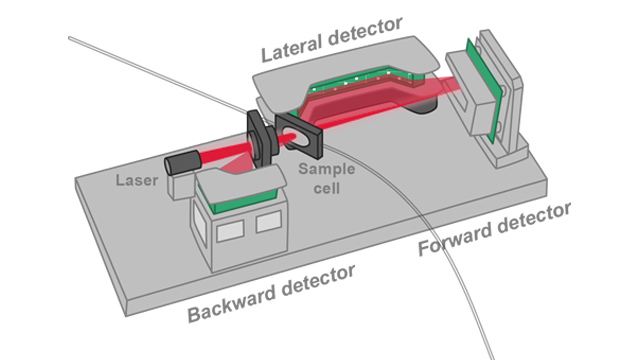
Zuverlässiges pneumatisches Probenahmesystem
Diese Konstruktion ermöglicht:
- Effektive Probenentnahme ohne Kreuzkontamination
- Gute Betriebssicherheit ohne Stromverbrauch
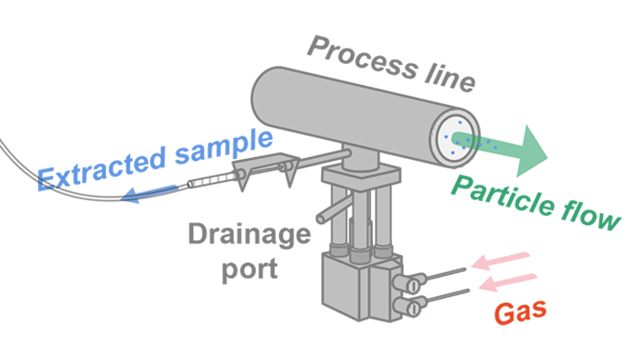
Erzielung einer optimalen Verdunkelung durch externe Verdünnung
In den meisten Fällen ist der Feststoffgehalt der Proben recht hoch, was zu einer hohen Verdunkelung führt, wenn die Proben in das BT-Online2 eingeführt werden. Daher ist ein externes Verdünnungssystem für die Primärverdünnung erforderlich.

Abgleich mit dem Laborgerät

Durch eine Leistungsüberprüfung wird sichergestellt, dass der vom BT-Online2 gelieferte Messwert mit dem Nennwert des Arbeitsreferenzstandards übereinstimmt.
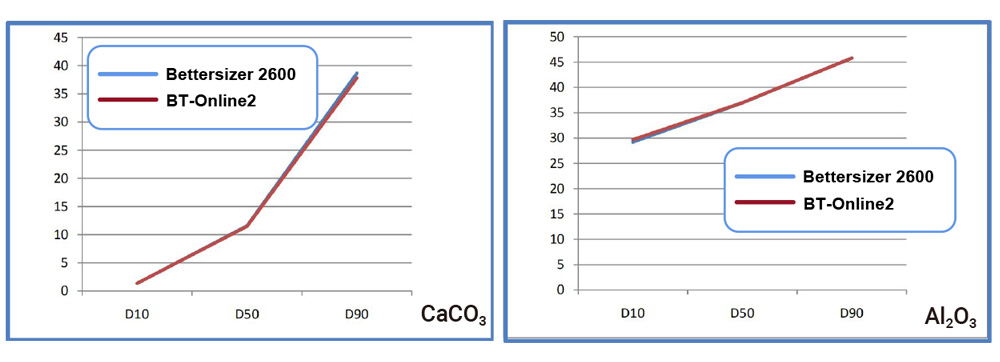
Die Ergebnisabweichungen zwischen dem BT-Online2 und dem Laborgerät sind recht gering - die Partikelgrößenkurven überschneiden sich fast.
Filtrationssystem ermöglicht Recycling von organischem Lösungsmittel
Wenn anstelle von Wasser ein organisches Lösungsmittel als Träger verwendet wird, ist ein bewegliches Filtersystem erhältlich, das Hand in Hand mit dem BT-Online2 arbeitet, um das organische Lösungsmittel zu recyceln und so Ihre Investition zu sparen.

Überwachung von bis zu 4 Prozesslinien
Bis zu 4 Prozesslinien können mit individuellen SOPs an das BT-Online2 angeschlossen werden. Das Messergebnis für jede Prozesslinie wird intuitiv in der Software angezeigt, was Investitionen in die Ausrüstung spart und das Datenmanagement vereinfacht.
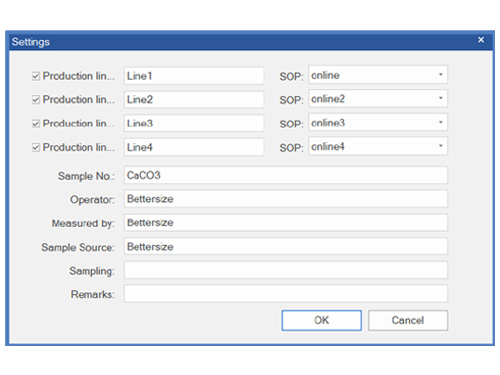
Anwendung
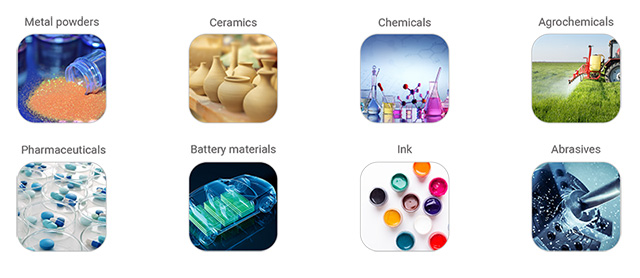
- Kontinuierliche und genaue Messung in verschiedenen Branchen
Ein patentiertes optisches System bietet genaue Messergebnisse mit hervorragender Reproduzierbarkeit.


- Messverfahren des BT-Online2 mit einem externen Verdünnungssystem
Als Zubehör kann ein externes Verdünnungssystem an das BT-Online2 angeschlossen werden, das eine Lösung für die Messung konzentrierter Proben im Falle von Mehrfachstreuung bietet. Das externe Verdünnungssystem hat 4 Einlassöffnungen, die 4 Prozesslinien entsprechen, und 1 Auslassöffnung für die Abgabe der primär verdünnten Probe.

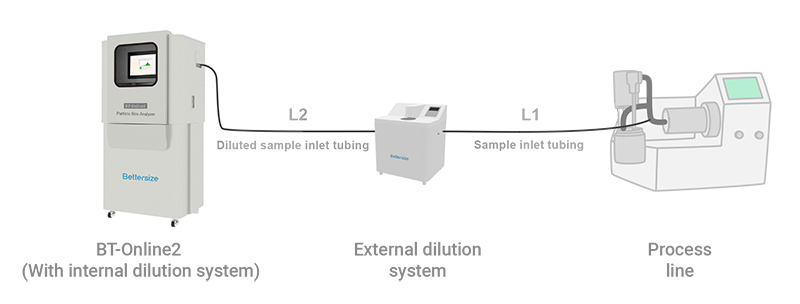
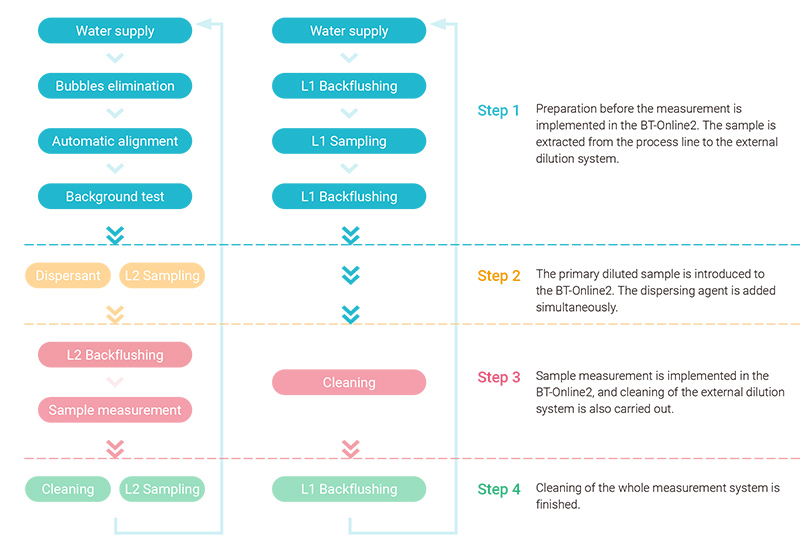
Citations
- Bettersizer 2600
Functional redundancy as an indicator for evaluating functional diversity of macrobenthos under the mussel raft farm near Gouqi Island
DOI: 10.1016/j.aquaculture.2023.740024 Read ArticleZhejiang Ocean University | 2024Biological traits analysis (BTA) helps to evaluate the effects of different environmental variables on the traits-based functional composition of macrobenthos. However, research on functional traits of macrobenthos under mussel farming is limited. We investigated the spatial and temporal response of the benthic system in terms of taxonomic and functional diversity to environmental variables of farming and natural stressors resulting from suspended mussel farming near Gouqi Island of eastern China Sea. The functional traits of macrobenthic assemblages under mussel farming were characterized by “medium adult body size”, “vermiform body form”, “high flexibility”, “infauna”, “semi-motile”, “gonochoristic”, “surface deposit-feeders”, “carnivores”, “semi-motile burrowers”, and “tube-dwellers”. Functional redundancy was stable in response to mussel farming stresses among seasons, whereas species diversity showed efficient to evaluate natural variables. Functional diversity was significantly affected by farming stressors rather than natural variables, Further analysis using multivariate methods together with continuous monitoring were highlighted to evaluate the impacts of mussel farming. Our results reinforce the importance of macrobenthic species and functional traits analysis to evaluate human stresses driven impacts in offshore ecosystems. By analysing the environmental variables with different sources, independently, we concluded the main effects of human pressures on macrobenthic community. Such distinction could be particularly effective to isolate variable environmental descriptors and evaluate their effects on functional diversity, making the current approach promising for the evaluation of ecological effects of anthropogenic stressors in aquaculture areas. - Bettersizer 2600
Degradation characteristics and utilization strategies of a covalent bonded resin-based solid amine during capturing CO2 from flue gas
DOI: 10.1016/j.seppur.2023.125621 Read ArticleChina University of Petroleum | 2024In this study, various types of degradation as well as attrition which are possibly encountered in a circulating fluidized bed temperature swing adsorption (CFB-TSA) process, were conducted experimentally to evaluate the stability of a resin-based solid amine sorbent. Other characterizations methods, such as elemental analysis (EA), Fourier transform infrared spectroscopy (FTIR) etc. were applied to further reveal the degradation mechanisms. The results showed that thermal degradation occurs from 140–160 °C due to the decomposition of amine group. The CO2-induced degradation occurs from a higher temperature of 160–180 °C accompanied by the production of urea. Hydrothermal stability is good below 130 °C, but the ionic impurities in steam crystalized on particle surface can accelerate the degradation. Oxidative degradation is the most harmful, which starts at a lower temperature of 70–80 °C with the formation of aldehyde. The existence of H2O in atmosphere can alleviate the oxidative and CO2-induced degradations. The employed sorbent has a very low attrition index of 0.05, which is 1–2 orders lower than typical commercial fluidized bed catalysts. Based on the results of stability evaluation, some design suggestions for proper utilization of this sorbent or other similar resin-based sorbents have been provided in an industrial CFB-TSA process.
- Bettersizer 2600
De-branching of starch molecules enhanced the complexation with chitosan and its potential utilization for delivering hydrophobic compounds
DOI: 10.1016/j.foodhyd.2023.109498 Read ArticleShihezi University | 2024The current study aimed to prepare the complexes between debranched-waxy corn starch and chitosan polymers (DBS-CS), and then investigated their corresponding structural characteristics, rheological property and potent application in Pickering emulsion. The results indicated that the existence of chitosan significantly inhibited starch short-range molecular rearrangement for all DBS-CS samples, which was manipulated by both debranching treatment and chitosan content. Interestingly, this is the first study to reveal that the outstanding peak at 1.8 ppm in 1H NMR spectrum for sample DBS-CS was gradually shifted towards a lower-field region following an increased chitosan content. Moreover, the debranching treatment shifted the crystallinity pattern from A-type to B-type and the relative crystallinity of DBS-CS decreased gradually with the increased content of CS. All samples had a pseudoplastic fluid and shear-thinning behavior with an enhanced shear resistance following the complexation. The DBS-CS was applied in a Pickering emulsion for showing a greater emulsifying stability and a lower gel strength than native NS-CS prepared emulsion. Importantly, the encapsulation ability of curcumin in the DBS-CS emulsion was significantly improved, followed by an increase of 15.45% for its corresponding bioavailability compared to the control. Therefore, this study might highlight a potential carrier for delivering the bioactive substances in a green pattern. - Bettersizer 2600
Heat-induced aggregation behavior of wheat gluten after adding citrus pectin with different esterification degree
DOI: 10.1016/j.foodhyd.2023.109420 Read ArticleGansu Agricultural University | 2024Wheat gluten aggregation during heat treatment is beneficial to the final quality of gluten-based products. Exogenous pectin can affect gluten aggregation. However, the effect of pectin with different degrees of esterification on the heat-induced aggregation behavior of gluten and its possible mechanism are still unclear. Thus, the heat-induced aggregation behavior of gluten after adding pectin with different esterification degree was studied in this study. When the temperature was raised from 25 °C to 95 °C, pectin affected gluten aggregation and was related to the degree of esterification. Specifically, the results of rheological properties and particle size indicated that low-ester pectin improved the viscoelasticity of gluten and promoted gluten aggregation. Thermal properties revealed that enthalpy of gluten added with low-ester pectin (37%) increased from 92.96 J/g to 95.40 J/g during heating process. Structurally, the fluorescence intensity and surface hydrophobicity of gluten added with low-ester pectin (37%) were lower than those added with high-ester pectin (73%). In addition, low-ester pectin (37%) significantly increased the disulfide bond content (from 15.31 μmol/g to 18.06 μmol/g) and maintained β-sheet content of gluten compared with gluten alone at 95 °C, indicating that low-ester pectin was more likely to induce gluten aggregation. However, scanning electron microscope showed that the gluten added with low-ester pectin (46%) exhibited a denser network structure at 95 °C than that added with low-ester pectin (37%). These results will provide a theoretical base for the regulation of gluten aggregation and the quality of gluten-based products by pectin with different esterification degree.
- 1
- 2
- 3
- 4
- 5
- 6
- 84
Ausgewählte Ressourcen
-
Bettersizer S3 Plus
Particle Size and Shape Analyzer
Measurement range: 0.01 - 3,500μm (Laser System)
Measurement range: 2 - 3,500μm (Image System)
-
Bettersizer ST
One-stop Particle Size Analyzer
Dispersion type: Wet
Measurement range: 0.1 - 1,000µm
Repeatability: ≤1% variation
-
Bettersizer 2600
Laser Diffraction Particle Size Analyzer
Measurement range: 0.02 - 2,600μm (Wet dispersion)
Measurement range: 0.1 - 2,600μm (Dry dispersion)
Measurement range: 2 - 3,500μm (Dynamic imaging)
-
BT-Online1
Online Particle Size Analyzer
Dispersion type: Dry
Measurement range: 0.1 - 1,000μm
Accuracy: ≤1% (D50 of certified reference material)

